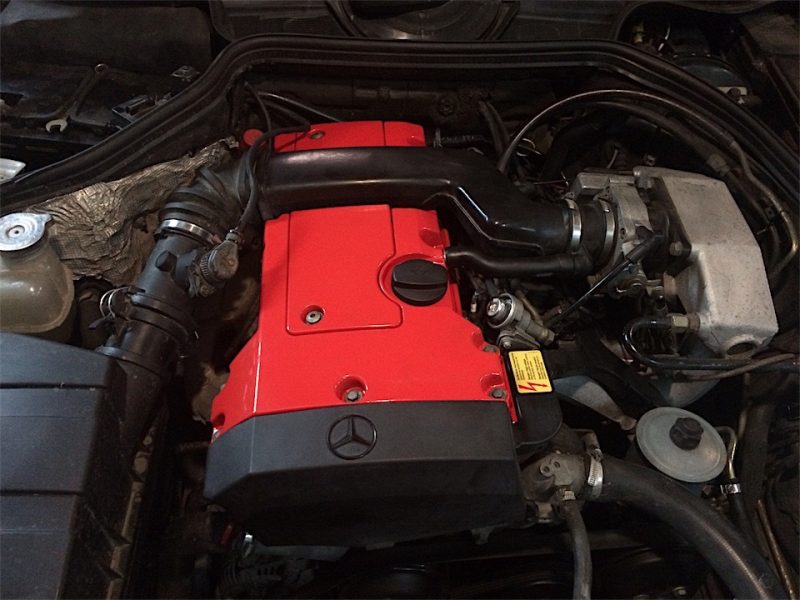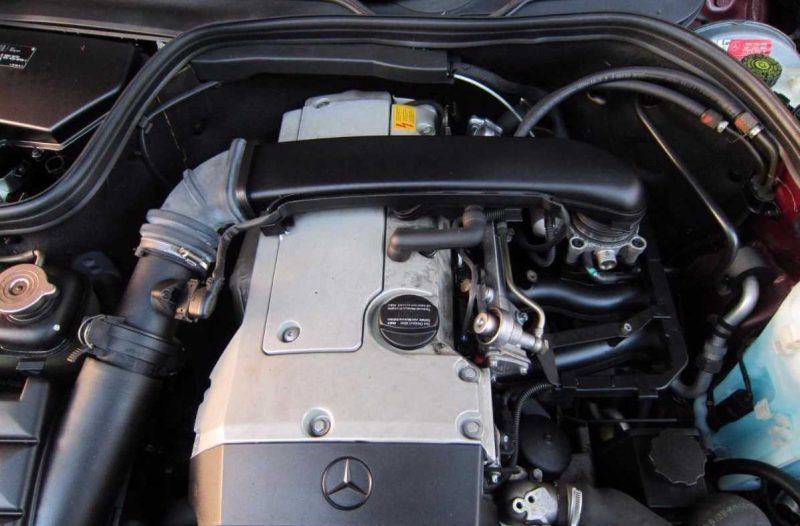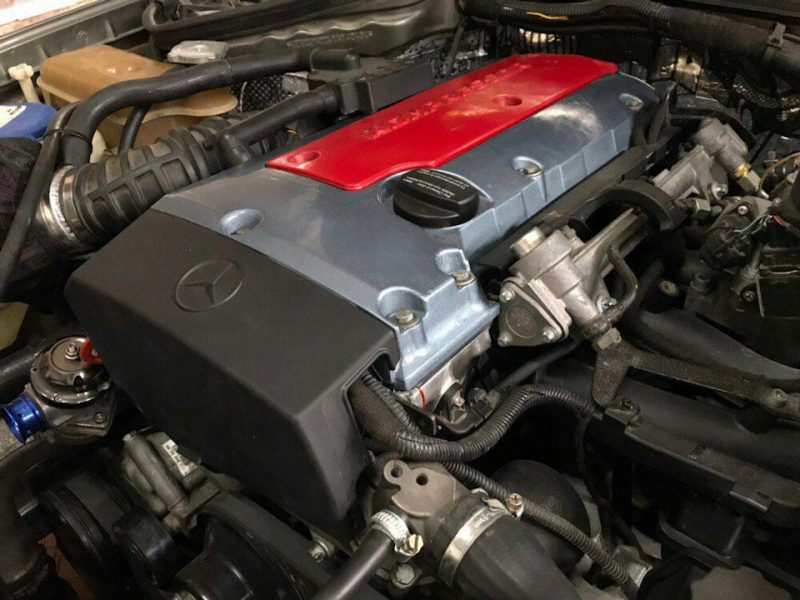Mercedes M111 power units are inline fours, the volume of which varies between 1.8 and 2.3 liters. The first motor of this series was released back in the distant 1992, and their production was completed only in 2006. It turns out that they were produced still for the Mercedes W124 car. Among the latest models that received the internal combustion engine under consideration today are the C-Class W203, the SLK R170 roadster, as well as the stylish CLK C208 coupe. The record longest time this powertrain lasted on the Sprinter W905. The most powerful model of this motor, with a volume of 2.3 liters, was put on the following cars: Volkswagen LT, as well as two SsangYong – Musso and Kuron.
If we are talking about inline fours M111, then there were not only atmospheric engines, but there were also variants with a Roots compressor. This variant was produced in the volume of 2.0 and 2.3 liters since 1995, and was installed mainly on the C-class W202. In general, this is a very powerful motor, because even the 1.8 atmospheric produced 122 hp, and the most powerful variant in 2.3 liters – had 197 horses, very impressive.
M111 power unit has a cast iron cylinder block, and the 16-valve cylinder head is made of aluminum. Needless to say, there are hydrocompensators in the valve train. There is also a phase shifter on the intake camshaft, and of a very unusual design.
PMS block on the W124, W202, W638
Already from the first day of production, M111 engines were equipped with electronic injection, and, moreover, with not the simplest control system PMS, which is responsible for controlling not only injectors, but also plugs. This system was developed by the famous firms Siemens and Bosch, and was produced by these manufacturers. PMS is responsible for measuring the load on the internal combustion engine using absolute pressure sensor. And its design feature is that the sensor is built into the block. Unfortunately, practice has shown that this is not the best solution, because the sensor itself is of poor quality and simply does not live long. And if it happened that he broke, the motorist had to buy the whole block, which is many times more expensive than just buy a sensor. With the passage of time, folk craftsmen have learned to unsolder this sensor and put a new one, but again, this is artisanal repair, for which not everyone will undertake. By a strange coincidence, motors with PMS were not put on W210. This system was exclusively on the first M111 motors of small volume – 1,8 and 2,0.
Closer to the year 2000, German engineers were able to seriously improve these engines: strengthened blocks, and connecting rods and pistons were strengthened under the increased compression ratio. In addition, changes were made to the cylinder head, and ignition coils were added. The first compressor versions are equipped with an Eaton M62 supercharger, driven by a separate belt through an electromagnetic clutch. But the EVO-versions are different, they are equipped with a supercharger of the same company, but already model M45, which has a permanent drive.
As already mentioned above, we removed 2.0 atmospheric engine M111.942, which was dismantled from the E-Class W210, with an output of 136 horses.
Compressor
In front of you is the Eaton M45 compressor, installed on 2.3 liter motors. The compressor under consideration – non-stop rotating, but exclusively when the power unit is running, pumping overpressure up to 0.37 bar.
It is interesting, but the manufacturer did not imply that the compressor is repairable. Only in practice, it is possible to find a set of needle bearings of screws without any problems. And the set will perfectly fit not only for M45, but also for Eaton M62.
It is possible to realize that the compressor is close to failure by strong howling and buzzing during driving. In addition, there is also mechanical damage to the screws and the compressor itself is covered with metal dust.
Reliability of the HFM system
The very first M111 engines, which were produced for the E-Class W210, had a powertrain management system, with a revolutionary for that period film flow meter, perfectly calculating the volume of intake air.

To the surprise of many, the HFM system turned out to be of extremely high quality, much better than the system installed before it. Unfortunately, it is not without its flaws. For example, it easily stops functioning if there is a short circuit in the wiring of the engine harness, in addition, it often breaks down due to a defect in the ignition coils. The only good thing is that the unit – can be repaired, but for this you need a competent electrician, which is not so easy to find.
Flow meter
This unit has a very impressive name – thermoanemometric mass air flow meter with a heated film. Not bad, right? This DMRV is installed even today, however, since that time it has received a lot of innovations. So, now it can send a digital signal to the control unit.
But in the power unit under consideration, the DMRV creates only an analog signal. Its operability is quickly and without special problems measured with a voltmeter: the voltage at the working part will be about 0.9-1 volt. If the voltage is higher – then the sensor is defective, which is fraught with sending false data to the control unit. To false information, the motor reacts as follows: uncertain start and unstable operation at idle. Problems with the film DMRV can happen only for one reason – contamination of the sensitive elements. Usually, oil residue or soot accumulates on it, which can be easily cleaned.
Carter gas ventilation system
At times, it regularly reminds about itself, because the permeability in the system can be disturbed. Most often, blockage occurs in the restrictor (entering the manifold), or in the tube coming from the oil separator.
To check the permeability, it is enough to dismantle the tube connecting the intake tract up to the flap and the valve cover. Of course, the hole in the valve cover will need to be closed (just put any object of suitable size to it) and make sure that there is suction. With the engine running, the air will be rapidly sucked into the valve cover, even at not the highest rpm. But if there is gas pressure coming from the valve cover, this is an indication of a ventilation problem. True, there is another reason: the power unit has accumulated an excessive amount of crankcase gases, and the culprit is the wear of the cylinder piston group.
If you have doubts about the functionality of the ventilation – try to get to the breather and the tube located in front of it. They are installed extremely inconveniently, right under the manifold, which makes it difficult to access them. One way or another, they will have to be checked, especially if the engine abundantly presses oil through the oil seals.
Crankshaft position sensor
One of the most famous vulnerabilities of motors of this series is the glitches of this sensor. The culprit is frequent overheating, destructively affecting the flimsy sensor. It comes to the point that at high heat it stops giving signs of life, and this leads to a complete shutdown of the motor. When it cools down, it will start. There is an option to try to breathe life into the overheated sensor, just carefully pour water on it. If everything worked, then congratulations, you have found a breakdown.
Throttle valve
The M111 engine family has two versions of the choke. In cars without cruise control and traction control, they are solely responsible for idling. But if both of these systems are present, the flaps are under the control of a special unit and have more autonomy. Simply put, they can not only cover the choke, but also open it completely. The flap varieties are pretty easy to distinguish: the normal version will have 8 contacts, while the flap with traction control and cruise control will have 14 already.
I doubt we will open America when we say that electronics start to malfunction with age. The miniature motor of the flap – breaks, or gradually degrades and stops working. In addition, the flap “malfunctions” from insulation spillage – this applies to the wires located directly in the housing. It is good to know that the potentiometer of the flap position sensor, very rarely gives headaches.

There are also electrical problems with the throttle:
- There is an error on this assembly.
- There are faults with the idle adjustment.
- Atypical reaction of the car to pressing the gas pedal.
In addition to the above-described common faults, there are cases when the power unit simply stalls, because of the additional load: turning on the air conditioner compressor, turning the steering wheel.
But if the damper is simply contaminated – the symptomatology changes greatly and becomes less noticeable. Most often, due to contamination, the internal combustion engine simply refuses to start.
And yes, do not forget that on “ancient” Mercs, released in the early 1990s, malfunctions with electronically controlled mechanisms are provoked by a dead “overload relay”. From time in it soldering falls apart. Experienced motorists know about this problem, so in advance, every few years, solder the contacts to be insured against a sudden problem.
The relationship between the throttle linkage and crankcase ventilation
Now let’s talk about the VKG again. On the upper tube, its entrance is located in the intake tract, just behind the DMRV and up to the throttle, at low speed of the power unit, air enters. But when speeding up and revs increase, crankcase gases come out of this tube. Funnily enough, it’s unfiltered oil vapor gases.
Because of this deficiency, oil vapors gradually begin to settle on the throttle, and eventually we get plaque.
There are also situations when oil vapors are reflected from the closed choke and reach the flow meter, where they settle.
Another unpleasant feature, well known to experienced motorists: at very low temperatures, if the engine is not warmed up sufficiently, moisture can circulate through the upper crankcase ventilation tube. This often becomes the cause of throttle freezing. In particularly bad cases, a light-colored scale appears: this is oil mixed with moisture.
What is the reason for this? Everything is simple, in abundant formation of condensate is to blame for insufficient warming of the power unit. After all, in severe frosts it is not so easy to do, so it simply does not have time to evaporate all the moisture that appears in the crankcase with air currents.
Phase Change Mechanism
For a very long period of time on the absolute majority of its motors, the Mercedes concern installed a nontrivial phase shifter. In particular, if we are talking about the M111 family, the clutch mechanism is located on the intake camshaft. The clutch is regulated by a solenoid connected to a hydraulic valve. Motorists nicknamed it very simply – “magnet”. “Magnet” is responsible for the movement of the spool, which opens access to the oil that drives the phase adjuster.

With the passage of time and increasing wear, the spool driven by the “magnet” begins to wedge. This most often happens on a “cold” start. The engine reacts instantly – it begins to shake and an error appears, indicating a problem with the clutch. To solve this problem, it is enough to dismantle the “magnet” and carefully loosen the spool installed in the camshaft.
In addition, there are situations, especially on cars with a huge mileage, when the connector of the magnet begins to ooze oil. But it can be corrected: it is enough to disassemble the “magnet” and seal it. Clutch knocking? Most often behind this is a decrease in the strength of the magnetic field. You will have to buy a new “magnet”.
The injectors
If the injectors are clogged, then the power unit begins to function jerkily, especially at idle, will lose power, and during speeding up there will be a stall. Many years of experience has perfectly demonstrated that the injectors Siemens Deka Z1, put on the engines 2.5 for “Volga” and “Gazelle”, are ideal for the considered today. And they are much cheaper.
Ignition coils
The M111 power unit is equipped with a pair of dual coils. They are very sensitive to the increased wear of plugs. So, if you notice ignition problems, be sure to pay attention to the plugs. Even if you put new coils on and the problems stop, they can return very quickly, as old plugs can wear out a coil in a couple of months.
The classic symptoms of ignition problems are: stalling while gaining speed, trolling, floating revs.
The timing chain
This is an extremely high quality chain that can withstand more than 300 thousand years. If it is stretched, it is easy to understand by floating revs and light clanking. German engineers anticipated this and introduced an elegant solution to control stretching. To solve the stretch problem, simply lock the camshafts and measure crankshaft misalignment. The camshafts are fixed with pins. If the crankshaft has shifted relative to the intake camshaft by more than 30 degrees, and the exhaust camshaft by 35 degrees or more – you will need to buy a new chain.
Pompa
One of the most problematic units of the considered motor. The main problem is the leakage of oil on the gasket.
Cylinder Block Head Gasket
It does not have the worst resource, as it can withstand up to 300 thousand, but then there can be a leak. Most often, the gasket leaks on the right, in the area of the generator. It is not difficult to eliminate this problem: dismantle the cylinder head and put a new gasket. And yes, do not forget to check the flatness of the “head” and replace the oil caps, if you do not want the problem to recur soon.
Piston group
According to the M111 internal combustion engines that have been in our hands and have passed not one hundred thousand kilometers, we can safely say that the cylinder piston group is above all praise.
In practice, many motorists have faced with oil burning, but it appears due to blistered oil caps and piston rings. The problem is quite solvable.



0 Comments